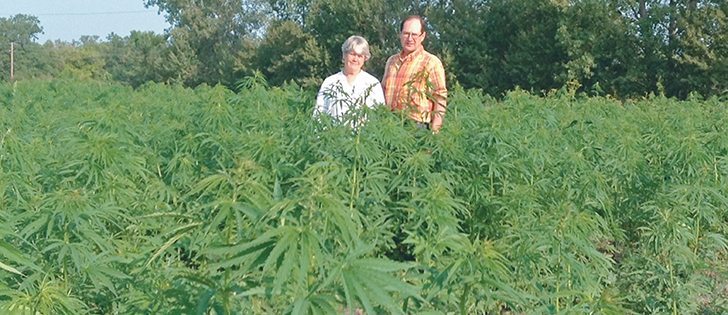DAUPHIN, Man. —Chris Dzisiak can almost propel a rock from the front door of his home to the one-room schoolhouse where he took Grades 1, 2 and 3.
Chris, in his late 50s, still lives in his childhood home. Although he hasn’t ventured far from his roots, he has probably lived a riskier and more adventurous life than people who have travelled to 50 countries.
Chris has farmed north of Dauphin for almost 39 years and recorded a lot of firsts over the last four decades. He’s been an early adopter throughout his career and consistently one of the first farmers in Manitoba to try an unproven crop.
Read Also

Communication key to bridging generation gap
Each generation is shaped by the predominant forces at play during their formative years. Acknowledging these influences can improve communication among the generations.
“We always grew alternatives. We tried winter canola … we grew (fababeans) … we tried triticale in 1978, 1979,” said Chris, who farms with his wife, Nadine, on land formerly owned by his parents.
“You always looked for alternatives to what everyone else was doing. If you were the first one into something new or novel, as long as it wasn’t too risky, the higher returns usually came to the first (adopters).”
Of all the unique crops he’s tried, Chris has had the most success with hemp.
He became one of the first producers in Canada to grow substantial acres of industrial hemp, following the federal government’s decision to legalize production in 1998.
Seventeen years later, Chris re-mains heavily involved in Canada’s hemp industry. He chairs the Parkland Industrial Hemp Growers (PIHG), a producer owned co-operative that produces and markets hemp seed and fibre.
On an unsettled June afternoon while a brief shower passed over the farm, Chris sat on a wicker chair inside a screened-in porch. Three dogs took shelter under the eave outside the porch as Chris talked about the PIHG and how he became a leader in Canada’s hemp industry.
After graduating from high school in Dauphin, Chris studied agriculture at the University of Manitoba with a plan to return home and farm with his older brother, Phil.
Chris’s younger brothers, Rob, Dave and Rick, were also U of M aggies. Dave helped develop Nexera canola for Dow Agrosciences, Rick worked in risk management for the Canadian Wheat Board and Rob has spent most of his career in the commodity trade.
Chris met Nadine at the university, where she was pursuing a graduate degree in English.
She grew up in Ottawa but adjusting to life in rural Manitoba wasn’t particularly difficult.
“I did have some farm relationships. My father came from the farm and every second year we drove from Ottawa to Hazelridge, Man., to visit with relatives,” said Nadine, who taught at the kindergarten to Grade 12 school in Grandview, Man. for 27 years before retiring in 2011.
“It wasn’t a jarring experience (to move to Dauphin) by any stretch.”
Chris and Phil farmed together until 1988, when Phil died in a boating accident.
Chris and his brother always be-lieved in the value of a diverse farm operation, so they included unique crops like fababeans in their rotation.
The novel crops also provided an opportunity to learn.
“It always made it interesting to get into something new,” said Chris, who used to farm about 2,500 acres but has cut back in recent years.
The hemp opportunity arrived when a fledgling hemp enterprise, Consolidated Growers and Processors, approached farmers in his region in the late 1990s.
The firm was looking for growers to supply a proposed processing plant in Manitoba.
Commodity prices were low and handful of area producers decided hemp was worth the risk.
“We said OK, we’ll put together some growers,” Chris said. “We (PIHG) will take care of the production end and you guys focus on the other end (sales).”
Consolidated Growers eventually went bankrupt but hemp established a foothold in the region. By 2001, area farmers were growing more than 12,000 acres of hemp.
The PIHG eventually forged a business relationship with other hemp processors, including Manitoba Harvest in Winnipeg.
Hemp fibres were expected to be the primary market but Chris thought hemp seed would also catch on.
“We also knew, fairly early, that the oil from the nut was going to be really good…. Good for your skin and good for eating.”
Hemp seed is now touted as superseed for its nutritional properties. U.S. sales of hemp foods and body care products reached $200 million last year.
Nadine said they try to eat hemp seed every day. They add it to breakfast cereal, salads and smoothies.
“The recommended dose is like four to five tablespoons per day,” she said. “We’ve reached an age where heart, cholesterol and all that has become important.”
Besides growing and marketing hemp, growers in the Parkland started a plant breeding program in 2002. They have registered six varieties for grain and/or fibre production.
Chris said the co-operative’s expertise in hemp production and varieties has helped build relationships with U.S. farmers.
Producers in Kentucky are now growing PIHG hemp varieties in experimental plots.
“We have a national distributor of our varieties in the U.S. now,” Chris said. “I’d like to see the Parkland varieties successfully adapted in the U.S. I think that would be a real (achievement).”
Since retirement, Nadine has worked as a substitute teacher and a principal in the local school division. Now that they’re semi-retired, she would like to travel more, but she knows it’s hard for Chris to leave the farm and his passion for agriculture.
For his part, Chris hopes he can play a role in the revival of hemp. He’s been a leader in the hemp industry for nearly two decades but his enthusiasm for the crop hasn’t waned.
“How many times do you get to be involved in something (like this)? It’s like being involved in canola in the late 1960s,” he said. “I’m not saying hemp is going to be as big as canola but it will become a major crop … in Western Canada.”
















